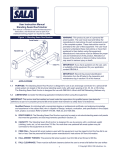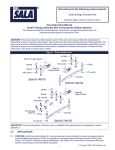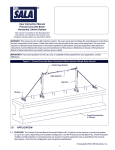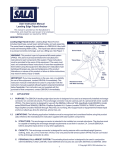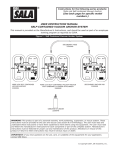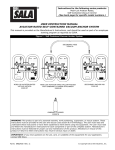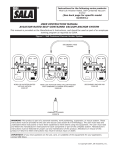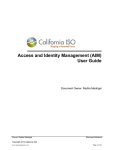Download 2104600 Concrete Column Anchor Instruction File
Transcript
WARNING: This product is part of a personal fall arrest system. The users must read and follow the manufacturer’s instructions for each component of the system. These instructions must be provided to the users of this equipment. The users must read and understand these instructions or have them explained to them before using this equipment. Manufacturer’s instructions must be followed for proper use, care and maintenance of this product. Alterations or misuse of this product or failure to follow instructions, may result in serious injury or death. Figure 1 - Concrete Column Anchor IMPORTANT: If you have questions on the use, care, or suitability for use of this equipment, contact DBI/SALA immediately. This instruction manual is intended to be used in conjunction with the Ultra-Lok® instruction manual Form: 5902407, if one has not been supplied, contact DBI/SALA immediately IMPORTANT: Record the product identification information from the ID label in the inspection and maintenance log in section 9.0 of this manual. DESCRIPTION 2104600: Column Form Anchor with Ultra-Lok® self retracting lifeline for 12 ft. Columns. See Figure 1. 2104601: Column Form Anchor with Ultra-Lok® self retracting lifeline for 16 ft. Columns See Figure 1. 1.0 1.1 APPLICATIONS PURPOSE: The Column Form Anchor with Ultra-Lok self retracting lifeline (SRL) is designed for use as part of a personal fall arrest system to protect the user in the event of a fall. The unit is intended to be secured to a concrete column form. A full body harness must be used in conjunction with this unit. The maximum free fall when using this equipment must be limited to two feet or less. See Figure 2 for application illustrations. WARNING: Do not use the Column Form Anchor with Ultra-Lok SRL for applications not addressed in this manual. 1.2 LIMITATIONS: Consider the following application limitations before using this equipment: 2104600 12 ft. model 2104601 16 ft. model A. CAPACITY: The Column Form Anchor with Ultra-Lok SRL is designed for use by one person with a combined weight (clothing, tools, etc.) of no more than 310 lbs. 1 © Copyright 2003, DB Industries, Inc. B. FREE FALL: This equipment must only be used when the maximum possible free fall is limited to two feet or less. See the Ultra-Lok SRL instructions for more information. Figure 2 -Applications FALL ARREST C. FALL ARREST FORCES: This unit may only be used with an integrally installed Ultra-Lok® self retracting lifeline, which limits the maximum fall arrest forces to 900 lbs in the event of a fall. D. FALL CLEARANCE: There must be sufficient clearance below the user to arrest a fall before the user strikes the ground or other obstruction. The clearance required is dependent on the following factors: • Initial height of the worker above the nearest obstruction • Free fall distance prior to fall arrest • Deceleration distance of the SRL • Movement of the harness attachment element relative to the worker • Height of the user • Weight of the user • Amount of Swing Fall See the Ultra-Lok SRL User Manual for more information. E. LOCKING SPEED: Situations which do not allow for an unobstructed fall path should be avoided. Working in very confined or cramped spaces may not allow the user to reach sufficient speed to cause the SRL to lock should a fall occur. A clear path is needed to assure positive locking of the SRL. F. SWING FALLS: Swing falls occur when the top of the anchor is not directly above the user when a fall occurs. The force of striking an object in a swing fall may cause serious injury or death. Minimize swing falls by working as directly in line with the web guide at the top of the unit as possible. Do not permit a swing fall if injury could occur. Swing falls will significantly increase the clearance required. G. ENVIRONMENTAL HAZARDS: Use of this equipment in areas with environmental hazards may require additional precautions to prevent injury to the user or damage to the equipment. Hazards may include, but are not limited to; heat, chemicals, corrosive environments, high voltage power lines, gases, moving machinery, and sharp edges. Contact DBI/SALA if you have questions about using this equipment where environmental hazards exist. H. TRAINING: This equipment must be installed and used by persons trained in its correct application and use. See section 4.0. 1.3 2.0 APPLICABLE STANDARDS: Refer to applicable standards, including local, state, and federal requirements for more information on personal fall arrest systems and associated components. SYSTEM REQUIREMENTS 2.1 COMPATIBILITY OF COMPONENTS: DBI/SALA equipment is designed for use with DBI/SALA approved components and subsystems only. Substitutions or replacements made with non-approved components or subsystems may jeopardize compatibility of equipment and may effect the safety and reliability of the complete system. 2.2 COMPATIBILITY OF CONNECTORS: Connectors are considered to be compatible with connecting elements when they have been designed to work together in such a way that their sizes and shapes do not cause their gate mechanisms to inadvertently open regardless of how they become oriented. Contact DBI/SALA if you have any questions about compatibility. Connectors (hooks, carabiners, and D-rings) must be capable of supporting at least 5,000 lbs. (22kN). Connectors must be compatible with the anchorage or other system components. Do not use equipment that is not compatible. Non-compatible connectors may unintentionally disengage. See Figure 3. Connectors must be compatible in size, shape, and strength. Self locking snap hooks and carabiners are required by ANSI Z359.1 and OSHA, and in Canada, by CSA Z259.12. 2 Figure 3 - Unintentional Disengagement (Roll-out) If the connecting element that a snap hook (shown) or carabiner attaches to is undersized or irregular in shape, a situation could occur where the connecting element applies a force to the gate of the snap hook or carabiner. This force may cause the gate (of either a self-locking or a non-locking snap hook) to open, allowing the snap hook or carabiner to disengage from the connecting point. Small ring or other non-compatibly shaped element 1. Force is applied to the snap hook. 2.3 2. The gate presses against the connecting ring. 3. The gate opens allowing the snap hook to slip off. MAKING CONNECTIONS: Only use self-locking snap hooks and carabiners with this equipment. Only use connectors that are suitable to each application. Ensure all connections are compatible in size, shape and strength. Do not use equipment that is not compatible. Ensure all connectors are fully closed and locked. DBI/SALA connectors (snap hooks and carabiners) are designed to be used only as specified in each product’s user’s instructions. See Figure 4 for inappropriate connections. DBI/SALA snap hooks and carabiners should not be connected: A. To a D-ring to which another connector is attached. B. In a manner that would result in a load on the gate. NOTE: Large throat opening snap hooks should not be connected to standard size D-rings or similar objects which will result in a load on the gate if the hook or D-ring twists or rotates. Large throat snap hooks are designed for use on fixed structural elements such as rebar or cross members that are not shaped in a way that can capture the gate of the hook. Figure 4 - Inappropriate Connections C. In a false engagement, where features that protrude from the snap hook or carabiner catch on the anchor and without visual confirmation seems to be fully engaged to the anchor point. D. To each other. E. Directly to webbing or rope lanyard or tie-back (unless the manufacturer’s instructions for both the lanyard and connector specifically allow such a connection). 3 F. 2.4 3.0 To any object which is shaped or dimensioned such that the snap hook or carabiner will not close and lock, or that roll-out could occur. ANCHORAGE STRENGTH: From OSHA 1926.500 and 1910.66: Anchorages used for attachment of a personal fall arrest system shall be independent of any anchorage being used to support or suspend platforms, and must support at least 5,000 lbs. per user attached; or be designed, installed, and used as part of a complete personal fall arrest system which maintains a safety factor of at least two, and is supervised by a qualified person. INSTALLATION AND USE WARNING: Do not alter or intentionally misuse this equipment. Consult DBI/SALA when using this equipment in combination with components or structures other than those described in this manual. Some circumstances may interfere with the operation of this equipment. Use caution when using this equipment around moving machinery, electrical hazards, chemical hazards, and sharp edges. WARNING: Consult your doctor if there is reason to doubt your fitness to safely absorb the shock from a fall arrest. Age and fitness seriously affect a worker’s ability to withstand falls. Pregnant women or minors must not use this equipment. 3.1 BEFORE EACH USE of this equipment inspect it according to section 5.0 of this manual. 3.2 PLAN your system before installation. Consider all factors that will affect your safety during use of this equipment. The following list gives important points to consider when planning your system: A. ANCHORAGE: The location selected for installation of the Concrete Column Form Anchor with Ultra-Lok® self retracting lifeline must be capable of supporting the loads specified in sections 2.4 and 3.3 . Install the anchor in a location that will minimize the fall hazard when the anchor is in use. B. SHARP EDGES: Avoid working where system components may be in contact with, or abrade against, unprotected sharp edges. Protect the self retracting lifeline from sharp edges by covering with a heavy pad. An energy absorber component should be added to the end of self retracting lifeline to further protect the lifeline when sharp edges are present. Refer to self retracting lifeline (SRL) instructions for more information. C. AFTER A FALL: Components which have been subjected to the forces of arresting a fall must be removed from service and destroyed, or returned to an authorized service center for repair. D. RESCUE: The employer must have a rescue plan when using this equipment. The employer must have the ability to perform a rescue quickly and safely. Figure 5 - Concrete Column Strength COLUMN FORM STRENGTH REQUIREMENTS 3.3 INSTALLATION: A. ANCHORAGE STRENGTHS: The form to which the column form anchor is secured must be stable and be capable of sustaining, without failure, the loads specified in Figure 5. B. ADJUSTING THE HOOK DEPTH: The hook, near the top of the column form anchor (see Figure 2) secures the unit over the top of the column form. The hook must be adjusted so it reaches completely over the column form and minimizes clearance between the form and the unit. The total clearance should be minimized to ensure stability of the column form anchor when standing on the work platform. See Figure 6. The hook may be adjusted to fit forms with a width of 2 in. to 6½ in. using standard side plates, and a width 5½ in. to 11 in. using extended side plates. Figure 7 shows the hook adjusted to both its narrowest and widest adjustment settings using the standard side and 4 COLUMN FORM MUST SUSTAIN THE STATED LOADS IN THE DIRECTIONS SHOWN 250 lbs 250 lbs 250 lbs 1800 lbs extended side plates. To adjust the hook depth, remove the bolts and nuts securing the side plates. Realign the holes in the side plates, hook end, and mast as required, and reinstall the bolts and nuts. Tighten the fasteners only until play is removed. Overtightening may damage the unit. C. ADJUSTING THE WORK PLATFORM HEIGHT: The platform may be adjusted to four different heights along the mast. To reposition the platform, remove the two bolts and nuts from the platform and position it at the desired location. Align the holes in the platform and mast, and reinstall the bolts and nuts. Tighten the fasteners only until play is removed. Overtightening may damage the unit. Figure 7 - Side Plate Settings Figure 6 - Hook Adjustment ADJUSTABLE TOP HOOK HOOK MUST FIT OVER CONCRETE FORM CONCRETE FORM, AND MINIMIZE CLEARANCE Figure 8 - Work Platform Height Settings Standard Side Plates HOOK END MAST 2 in. ALTERNATIVE PLATFORM HEIGHTS 6-1/2 in. Extended Side Plates WORK PLATFORM 5-1/2 in. 11 in. Figure 9 - Installing The Extension D. COLUMN FORM ANCHOR LENGTH: The column form anchor length can be modified to fit forms which are approximately 12 feet tall (no extension is used) PN 2104600 or those which are approximately 16 feet tall (an extension is used) PN 2104601. 1. ADDING THE EXTENSION TO THE MAST: The following steps are required to increase the length of the unit by adding the extension: Remove the nut, bolt, washer, and ratchet buckle assembly from the bottom of the mast. Insert the mast extension in the bottom of the mast and secure it in place with the nut and bolt provided. Install the nut, bolt, washer and ratchet buckle assembly previously removed to the bottom of the extension. See Figure 9. Tighten the fasteners only until play is removed. Overtightening may damage the unit. INSTALL EXTENSION, REMOVE NUT, WASHER, RATCHET BUCKLE, AND BOLT FROM MAST INSTALL NUT, WASHER, RATCHET BUCKLE, AND BOLT TO EXTENSION 5 BOLT, AND NUT 2 REMOVING EXTENSION FROM MAST: To shorten the length of the unit, remove the nut, bolt, washer and ratchet buckle assembly from the bottom of the extension. Remove the nut and bolt securing the mast extension in the bottom of the mast and remove the extension. Install the nut, bolt, washer, and ratchet buckle assembly previously removed to the bottom of the mast. Tighten the fasteners only until play is removed. Overtightening may damage the unit. Figure 10 - Reposition Hook E. INSTALLING UNIT ON CONCRETE COLUMN FORMS: Before beginning to install the concrete column form anchor, attach a tagline to the snap hook of the SRL or grasp the snaphook and pull out enough of the lifeline to attach the hook onto the bolt on the back of the SRL mounting frame. See Figure 10. Lift the column form hook over the top of the form and position it as shown in Figure 6. Ensure the hook completely reaches over the column form with a minimum of clearance. Release and extend the hook end of the ratchet strap by pulling the lever on the ratchet buckle and move the ratchet buckle to the “full open” position. Wrap the hook end of the ratchet strap around the column form and secure the hook end to the ratchet as shown in Figure? Remove slack in the ratchet strap with ratchet buckle until strap is taut. The ratchet buckle handle must be returned to the “full closed” position before use to lock the ratchet strap around the column form. Figure 11 shows the ratchet buckle in the “full closed” position. 3.4 4.0 4.1 USE: Once the column form anchor has been properly installed and inspected, the anchor is ready for use. Attach the SRL snap hook to the dorsal (back) D-ring of the full body harness before climbing the column form. Once the worker reaches the platform level, remain connected to the SRL. When using a secondary work positioning system, connect to the concrete form rather than to the column anchor. After descending from the concrete column anchor, disconnect the SRL lifeline snap hook from the dorsal D-ring on the worker’s harness and attach the snap hook to a tagline and allow the SRL to retract the snap hook to the top of the column anchor, or, for convenience, attach the snap hook to the bolt on the frame holding the SRL at the bottom of the anchor mast. However, the SRL should be allowed to retract if it will not be used for long periods or if the concrete column anchor form is being transported. ATTACH SNAP HOOK TO BOLT ON FRAME Figure 11 - Closed Ratchet Buckle FULL CLOSED HANDLE POSITION TRAINING It is the responsibility of the user to assure they are familiar with these instructions, and are trained in the correct care and use of this equipment. User must also be aware of the operating characteristics, application limits, and the consequences of improper use of this equipment. IMPORTANT: Training must be conducted without exposing the user to a fall hazard. Training should be repeated on a periodic basis. 6 5.0 5.1 INSPECTION FREQUENCY: • Before Each Use: Inspect Column Form Anchor with Ultra-Lok® SRL according to sections 5.2 and 5.3. • Formal Inspection: A formal inspection of the Column Form Anchor with Ultra-Lok SRL must be performed at least annually by a competent person other than the user. The frequency of formal inspections should be based on conditions of use or exposure. Record the inspection results in the inspection and maintenance log in section 9.0. • After a Fall: Equipment which has been subjected to fall arrest forces must be removed from service for inspection. If the red stitching on the SRL lifeline is broken and the fold is torn apart, the SRL has been impacted and the entire concrete column form anchor must be removed from service and returned to an authorized service center for repair. 5.2 INSPECTIONS: (refer to instruction manual Form: 5902407 for Ultra-Lok inspection procedures) A. Inspect column form anchor for damage or corrosion. Inspect for cracks or wear that may affect its strength. Ensure all fasteners are secure. B. Inspect each system component or subsystem (e.g., full body harness) per associated manufacturer’s instructions. C. Record the inspection date and results on the inspection log. See section 9.0. 5.3 6.0 If inspection reveals an unsafe or defective condition, remove column form anchor from service and destroy. MAINTENANCE 6.1 Clean Column Form Anchor with Ultra-Lok SRL with a mild soap solution. 6.1 Remove any buildup of cement/concrete from the SRL lifeline as soon as possible to avoid damage to the lifeline. 7.0 SPECIFICATIONS Weight: Aprox. 35 lbs. (Standard Version with Ultra-Lok® SRL) Length: 138" (Standard Version) Materials: Mast and brackets: High strength aluminum Fasteners: Stainless steel and plated steel Guides and Rollers: Nylon Strength: The column form anchor with Ultra-Lok SRL maintains a minimum safety factor of 2 as required by OSHA when used according to this user instruction manual (reference OSHA 1926.502 and 1910.66) Capacity: 310 lbs. (one person) 7 This label should be securely attached to the concrete column anchor and be fully legible. WARNING DBI/SALA 3965 Pepin Ave Red Wing, MN 55066 800-328-6146 SRL LIFELINE HOOK WORK PLATFORM MODEL NO: TOP ROLLER (YR/MO)NO: MFRD LOT STRAP COLUMN FORM ANCHOR COLUMN FORM Manufacturer's instructions supplied with this product at time of shipment must be followed for proper use, maintenance and inspection. Alteration or misuse of this product, or failure to follow instructions may result in serious injury or death. Make only compatible connections. Ensure form is secure before using anchor. RATCHET BUCKLE R GUIDE 8.1 LABELING TOP 8.0 INSTALLATION AND USE: Ensure that column form is stable and secure prior to installing and using Adjust hook to fit column form. Connect anchor over the top of column form. hook engages section of column form capable of sustaining fall arrest forces. Secure anchor with strap and tighten ratchet buckle securely. Ensure that buckle remains closed and locked during use. Do no climb above work platform. Use caution near overhead obstructions and electrical sources. Refer to User SPECIFICATIONS: INSPECTION: Capacity: Personnel maximum working load 310 lbs. Max arrest force 900 lbs. Before each use, inspect anchor to ensure it is in good condition and working properly. At least annually anchor must be inspected by a competent person in accordance with the User Manual. Do not use if inspection reveals an unsafe or defective condition. Not user repairable. Refer to other labels and User Manual. Materials: Aluminum Standards: Meets OSHA requirements 9500870 REV A 8 anchor. Ensure ratchet Manual. 9.0 INSPECTION AND MAINTENANCE LOG DATE OF MANUFACTURE: _______________________________________________________________________ MODEL NUMBER: ______________________________________________________________________________ DATE PURCHASED: ____________________________________________________________________________ INSPECTION DATE INSPECTION ITEMS NOTED CORRECTIVE ACTION Approved By: Approved By: Approved By: Approved By: Approved By: Approved By: Approved By: Approved By: Approved By: Approved By: Approved By: Approved By: 9 MAINTENANCE PERFORMED 9.0 INSPECTION AND MAINTENANCE LOG DATE OF MANUFACTURE: _______________________________________________________________________ MODEL NUMBER: ______________________________________________________________________________ DATE PURCHASED: ____________________________________________________________________________ INSPECTION DATE INSPECTION ITEMS NOTED CORRECTIVE ACTION Approved By: Approved By: Approved By: Approved By: Approved By: Approved By: Approved By: Approved By: Approved By: Approved By: Approved By: Approved By: 10 MAINTENANCE PERFORMED 9.0 INSPECTION AND MAINTENANCE LOG DATE OF MANUFACTURE: _______________________________________________________________________ MODEL NUMBER: ______________________________________________________________________________ DATE PURCHASED: ____________________________________________________________________________ INSPECTION DATE INSPECTION ITEMS NOTED CORRECTIVE ACTION Approved By: Approved By: Approved By: Approved By: Approved By: Approved By: Approved By: Approved By: Approved By: Approved By: Approved By: Approved By: 11 MAINTENANCE PERFORMED USA 3965 Pepin Avenue Red Wing, MN 55066-1837 Toll Free: 800-328-6146 Phone: (651) 388-8282 Fax: (651) 388-5065 www.salagroup.com Canada 260 Export Boulevard Mississauga, Ontario L5S 1Y9 Toll Free: 800-387-7484 Phone: (905) 795-9333 Fax: (905) 795-8777 www.salagroup.com This manual is available for download at www.salagroup.com. I S O 9001 Certificate No. FM 39709 12 Form: 5902287 Rev: A












